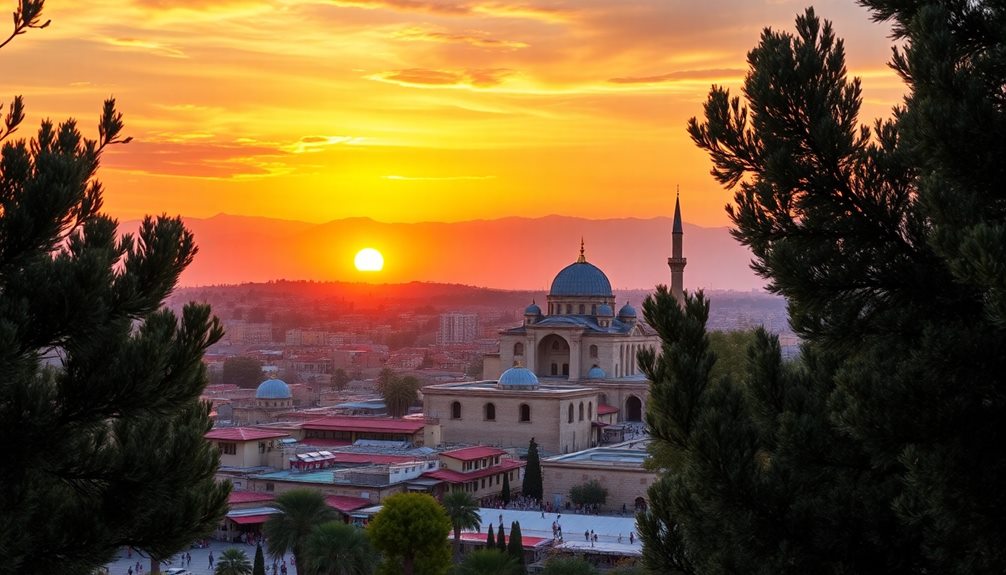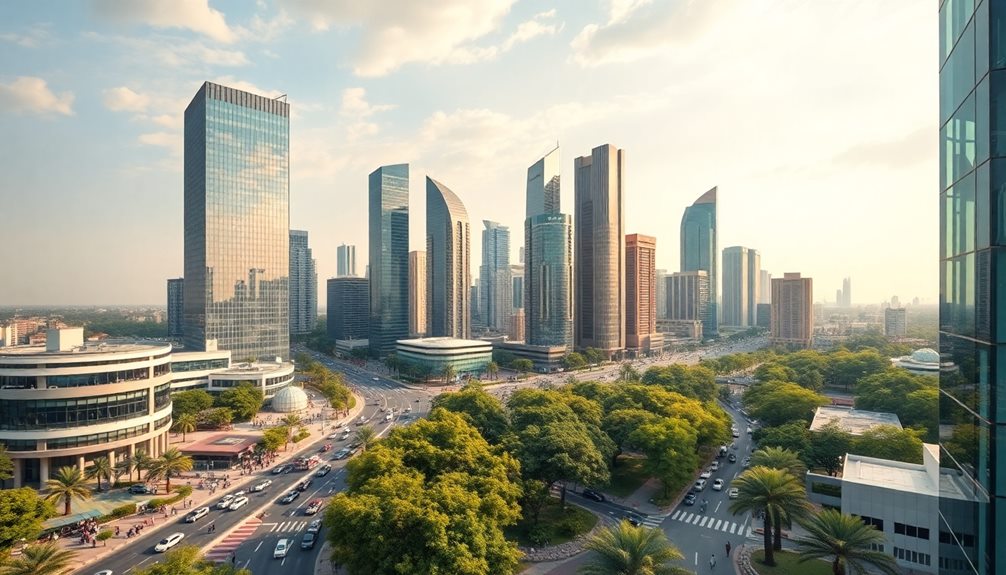When you explore Damascus, you're stepping into the world's oldest continuously inhabited city, rich with history dating back over 8,000 years. This UNESCO World Heritage Site showcases stunning architecture, like the Umayyad Mosque and Azem Palace, alongside vibrant markets such as Souq al-Hamidiyya, where you can taste local cuisine and shop for unique crafts. Wander through its ancient streets, and you'll feel the blend of cultures and traditions that have shaped this fascinating city. If you want to uncover more about Damascus and its incredible heritage, there's so much more waiting for you to discover!
Key Takeaways
- Damascus is recognized as the world's oldest continuously inhabited city, with evidence of habitation dating back 8,000-10,000 B.C.
- The city served as a cultural and commercial hub for ancient civilizations, including the Aramaeans and Umayyad Caliphate.
- UNESCO designated Damascus a World Heritage Site in 1979, highlighting its 125 historical monuments.
- Architectural wonders like the Umayyad Mosque and Azem Palace reflect the city's rich cultural influences.
- Visitors can explore vibrant markets like Souq al-Hamidiyya, experiencing traditional cuisine and crafts unique to Damascus.
Introduction

When you think of ancient cities, Damascus likely comes to mind as one of the most remarkable. Recognized as the oldest continuously inhabited city in the world, it boasts a rich history that spans thousands of years. Evidence of human habitation dates back to 8,000-10,000 B.C., showcasing its significance as a cultural and commercial hub for various civilizations, including the Aramaeans and the Umayyad Caliphate. Its ancient walls and historic landmarks tell stories of empires, trade routes, and incredible resilience through the ages. Just as Damascus offers a window into humanity’s enduring legacy, discovering cultural roots in Varanasi provides a similarly profound connection to the past. Both cities serve as living museums, preserving traditions and history that continue to inspire and captivate the modern world.
Located in southwestern Syria, near the Anti-Lebanon mountain range, Damascus has been a vital crossroads for trade and cultural exchange. This strategic position contributed to its historical importance and agricultural richness. Designated a UNESCO World Heritage Site in 1979, the city features approximately 125 historical monuments that reflect a stunning blend of Hellenistic, Roman, Byzantine, and Islamic influences.
Despite its incredible cultural heritage, Damascus has faced considerable challenges in recent years, including ongoing conflicts and being labeled the least livable city globally in 2019 and 2023.
Yet, the resilience of its people and the enduring beauty of its history continue to inspire those who seek to understand this extraordinary city.
Background

The rich history of Damascus stretches back to its founding in the 3rd millennium B.C., making it one of the oldest continuously inhabited cities on the planet. Evidence shows that people have lived here for 8,000 to 10,000 years, creating a vibrant tapestry of cultures and influences.
The arrival of the Aramaeans transformed Damascus into a prominent cultural and commercial hub. From 661 to 750 AD, it served as the capital of the Umayyad Caliphate, a period marked by significant urban development and architectural achievements.
Today, the Old City of Damascus stands as a testament to this rich heritage, featuring around 125 monuments from various historical periods. In 1979, UNESCO designated it a World Heritage site, recognizing its Outstanding Universal Value.
The city's layout reflects Roman planning, with a grid pattern that still shapes its streets, alongside notable archaeological sites like the Temple of Jupiter and remnants of Roman walls.
Throughout the centuries, Damascus has weathered conflicts, power shifts, and natural disasters, each leaving its mark on the city's unique cultural landscape. Understanding this background sets the stage for appreciating the cultural richness that continues to thrive in Damascus today.
Cultural Heritage and Traditions

Cultural heritage in Damascus is a vibrant tapestry woven from centuries of diverse influences. As you explore the Old City, you'll encounter the stunning Umayyad Mosque, one of the earliest great mosques in Islam. Its architectural beauty reflects the city's layered history as it transitioned from a temple to a church and finally to a mosque.
Additionally, the rich cultural practices of other communities, such as traditional healing practices, contribute to the diverse tapestry of influences that shape the city's identity.
Walking through the bustling souks, like Souq al-Hamidiyya, you'll experience a lively marketplace filled with rich spices, sweets, and handcrafted goods that showcase local culture and commerce.
Damascene cuisine further highlights this cultural heritage, offering a delectable array of dishes such as kebabs, hummus, and baklava, each influenced by the city's diverse past.
You'll also find that cultural events and festivals thrive in Damascus, celebrating music, dance, and crafts that preserve local traditions.
These festivities not only honor the past but also keep the spirit of Damascus alive, despite the modern challenges it faces. By immersing yourself in these experiences, you'll appreciate how the city's cultural heritage continues to shape its identity, making it a truly unique place to visit.
Tourist Enthusiasm and Fascination

Throughout the ages, travelers have been drawn to Damascus, captivated by its allure as the world's oldest continuously inhabited city. With a rich history that dates back 8,000 to 10,000 B.C., the old city of Damascus offers a unique glimpse into the past. Wandering through its ancient streets, one can encounter remnants of the various civilizations that once thrived here, from the Arameans and Romans to the Ottomans. The architecture, bustling souks, and historic landmarks such as the Umayyad Mosque all tell the story of Damascus’ enduring significance. As the **oldest continuously inhabited city**, it stands as a living testament to human resilience and cultural evolution over millennia.
As you wander through its ancient streets, you'll encounter stunning architectural highlights like the Umayyad Mosque and Azem Palace, showcasing the city's diverse cultural influences.
You can immerse yourself in the vibrant atmosphere of the souks, especially Souq al-Hamidiyya, where traditional Syrian cuisine, spices, and crafts await your discovery. This lively marketplace invites you to taste the flavors of the region and explore its artisanal offerings.
Despite the ongoing conflicts, Damascus's UNESCO World Heritage status continues to attract those interested in its historical and cultural significance. Your passion for preserving this incredible city's heritage aligns with efforts to maintain its beauty and history for future generations.
The blend of ancient landmarks, modern urban life, and lush gardens ensures that you'll leave Damascus with unforgettable memories, deepening your appreciation for Middle Eastern heritage and its enduring allure.
Career Opportunities in Tourism

With its rich history and UNESCO World Heritage status, Damascus offers a wealth of career opportunities in the tourism sector. If you're passionate about preserving cultural legacies, roles in heritage conservation could be your calling. You can work on projects that maintain the integrity of historic sites while promoting their significance to visitors.
Tourism management positions are also on the rise, especially as the city recovers from past conflicts. You could find yourself coordinating travel plans that prioritize safety and cultural exchange, ensuring tourists have enriching experiences.
Additionally, the bustling markets like Souq al-Hamidiyya create openings in hospitality, retail, and culinary sectors, allowing you to engage with local commerce while enhancing the tourist experience.
If you have a knack for storytelling, consider becoming a tour guide. Visitors seek knowledgeable individuals who can share the rich narratives of landmarks such as the Umayyad Mosque and Azem Palace.
Furthermore, with ongoing urban development initiatives, you can contribute to sustainable tourism efforts that balance modern needs with the preservation of Damascus's unique cultural heritage. Embrace the chance to be part of this vibrant tourism landscape!
Frequently Asked Questions
Which Is the Oldest Continuously Inhabited City in the World?
You might find that the oldest continuously inhabited city in the world is often debated. However, many historians point to Damascus, with its evidence of human activity stretching back thousands of years, as a leading contender.
Why Is Damascus Important to History?
Damascus is important to history because it's a cultural and commercial crossroads, showcasing diverse architectural styles and influences from various civilizations. Its rich heritage and historical significance deeply resonate with anyone exploring the ancient world.
What Happened to the City of Damascus?
You'll find that Damascus has faced significant challenges over the years, including political turmoil, wars, and urban decay. These factors have drastically affected its safety, livability, and preservation, leading to its current vulnerable state.
Where Is the Biblical City of Damascus?
You'll find the biblical city of Damascus in southwestern Syria, about 130 kilometers from Beirut, Lebanon. Its rich history and significance in various texts make it a fascinating destination for exploring ancient cultures.










